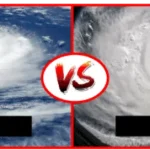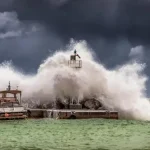Tropical Cyclone: Nature’s Most Powerful Storm

A tropical cyclone is one of the most powerful and destructive weather phenomena on Earth. Characterized by strong winds, heavy rain, and spiraling storm systems, these intense storms can wreak havoc on coastal regions, causing widespread damage and loss of life.
Understanding what a tropical cyclone is, how it forms, and the impact it has on both natural and human environments is crucial for preparing for and mitigating the risks associated with these natural disasters.
What Is a Tropical Cyclone?
A tropical cyclone is a rotating, low-pressure weather system that forms over warm tropical or subtropical waters. It is distinguished by its organized thunderstorms and a distinct eye at the center of the storm. Tropical cyclones are known by different names depending on where they occur:
- Hurricanes: Atlantic Ocean and Northeast Pacific
- Typhoons: Northwest Pacific
- Cyclones: South Pacific and Indian Ocean
Regardless of the name, these storms follow similar patterns of formation, intensity, and potential for destruction.
How Does a Tropical Cyclone Form?
Tropical cyclones require specific conditions to form, which is why they primarily develop in tropical regions. These are the key elements necessary for a cyclone to develop:
Warm Ocean Waters
The most critical factor in the formation of a tropical cyclone is warm ocean water, typically above 26.5°C (80°F). Warm water serves as the fuel for the storm, as it causes large amounts of moisture to evaporate from the ocean surface.
Atmospheric Instability
An unstable atmosphere, where warm, moist air near the surface rises and cooler, dry air descends, creates the convection needed for storm development. This vertical movement of air helps create the strong thunderstorms that form the core of a tropical cyclone.
 Typhoons: Understanding Nature’s Powerful Storms
Typhoons: Understanding Nature’s Powerful Storms
Low Wind Shear
Wind shear refers to the change in wind speed or direction at different altitudes. Low wind shear is essential for a tropical cyclone to form because it allows the storm to remain vertically aligned. High wind shear can disrupt the structure of the storm, preventing it from developing or weakening it if it has already formed.
Coriolis Effect
The rotation of the Earth causes a deflective force known as the Coriolis effect, which is necessary for a cyclone to develop its characteristic spinning motion. This is why tropical cyclones do not form directly at the equator, where the Coriolis effect is too weak.
Structure of a Tropical Cyclone
Tropical cyclones are highly organized storm systems with several distinct features:
Eye
At the center of the storm is the eye, a calm, clear area of relatively low pressure. The eye can range from 20 to 40 kilometers in diameter. Despite the tranquil conditions within the eye, it is surrounded by the most intense part of the storm—the eyewall.
Eyewall
The eyewall consists of a ring of towering thunderstorms that surround the eye. This is where the storm’s strongest winds and heaviest rainfall occur. Winds in the eyewall can exceed 150 kilometers per hour (93 mph), causing extreme damage when they make landfall.
Rainbands
Outside the eyewall are rainbands, which are long, curved bands of thunderstorms. These bands spiral outward from the storm’s center and can extend hundreds of kilometers. Rainbands bring heavy rain and strong winds, often leading to flooding and landslides in affected areas.
Classification of Tropical Cyclones
Tropical cyclones are classified based on their wind speeds and potential for damage. Here are the main categories:
 Hurricane and Tropical Cyclone: Understanding the Powerful Storm Systems
Hurricane and Tropical Cyclone: Understanding the Powerful Storm Systems
- Tropical Depression: A tropical system with wind speeds less than 63 km/h (39 mph).
- Tropical Storm: Winds range between 63 and 118 km/h (39-73 mph). At this stage, the storm is given a name.
- Hurricane/Typhoon/Cyclone: When wind speeds exceed 119 km/h (74 mph), the storm becomes a full-fledged cyclone. Depending on its intensity, it may be further categorized using the Saffir-Simpson Hurricane Wind Scale (Categories 1-5).
The Saffir-Simpson Hurricane Wind Scale
The Saffir-Simpson scale categorizes hurricanes by their sustained wind speeds, with Category 5 being the most destructive:
- Category 1: 119-153 km/h (74-95 mph)
- Category 2: 154-177 km/h (96-110 mph)
- Category 3: 178-208 km/h (111-129 mph)
- Category 4: 209-251 km/h (130-156 mph)
- Category 5: 252+ km/h (157+ mph)
Impact of Tropical Cyclones
Tropical cyclones can cause catastrophic damage, especially when they make landfall in populated areas. The primary hazards associated with tropical cyclones include:
Storm Surge
The most deadly and destructive aspect of a tropical cyclone is often the storm surge—an abnormal rise in sea level caused by the storm’s winds pushing water toward the shore. Storm surges can inundate coastal communities, flooding homes, roads, and infrastructure, and causing widespread destruction.
Wind Damage
The powerful winds of a tropical cyclone can destroy buildings, uproot trees, and down power lines. Strong winds can also cause debris to become dangerous projectiles, adding to the devastation.
Heavy Rain and Flooding
Tropical cyclones can produce torrential rainfall, leading to flash floods and landslides, especially in mountainous regions. Even after the storm has weakened, the lingering rainfall can cause flooding in areas far from the initial landfall site.
Economic and Social Disruption
The destruction caused by tropical cyclones can take years to recover from. Homes, businesses, and critical infrastructure like hospitals and roads are often damaged or destroyed, leading to significant economic losses. Communities may also face long-term challenges such as displacement, loss of livelihood, and shortages of food and clean water.
Preparing for Tropical Cyclones
Being prepared is essential for minimizing the impact of tropical cyclones. Governments and individuals can take several steps to reduce the risks:
 Tsunami: Understanding Nature’s Most Powerful Wave
Tsunami: Understanding Nature’s Most Powerful Wave
- Early Warning Systems: Governments use satellite data and meteorological models to track tropical cyclones and provide early warnings. Evacuation orders and public safety announcements are critical to saving lives.
- Disaster Preparedness Plans: Individuals and communities should have disaster preparedness plans in place, including evacuation routes, emergency supplies, and communication plans.
- Building Resilience: In cyclone-prone areas, buildings can be designed to withstand high winds, and flood defenses such as levees or sea walls can reduce the impact of storm surges.
Tropical cyclones are among nature’s most powerful and destructive forces, with the potential to cause significant loss of life and property. By understanding how these storms form, recognizing their dangers, and preparing effectively, communities can better protect themselves from the devastating impacts of tropical cyclones.






